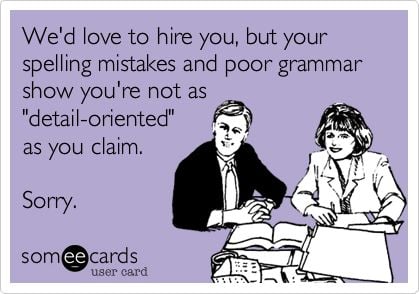Thinking about revising your resume but it just feels too painful? We’re here to make it easier. Resumes, after all, are supposed to be a quick summary of skills and history—YOU are the star who’ll shine in your interview with a portfolio at your side. Let’s make your resume fail-proof, shall we? Here are just 5 components you’ll need to focus on:
1. Skills
Start with your skills (a) because you likely have a long list that you’ll need to edit down and (b) it’ll keep you in high spirits to bask in all your talents. Organize your skills by type and create bulleted points like this:
- Design, UX, and/or Writing Tools
- Project Management Tools
- Standard Office Tools
- Hard Skills (i.e. Brand Book Creation, Social Media Campaigns, etc.)
List about 3-5 of the most important and pertinent skills within each bullet point. But, for the love of god, please do not "rank" your skills. Everyone is better at some things than others but doing this will just draw attention to the skills you're not done mastering.
2. Details on 3-5 related positions
Gone are the days when you had to cram everything possible into your resumes just to get noticed. Today, it’s much better to let your resume breathe while tailoring it to the job you’re applying for. You already know that odd numbers are best for design, so pick 3 or 5 positions that are closely related to the job you’re seeking. Include your title, the month and years active, as well as the company you worked for. While career gaps aren't the kiss of death that they were in the past, but you will still want to include what you were doing in between each of these roles. Just keep each mention simple and concentrate on roles you're really proud of and highlight them. However, within those highlighted positions…
3. The biggest areas of impact you made within each position
Resumes used to be about your responsibilities within each role. These days responsibilities are par for the course. Of course, if you’re a digital designer for a fashion retailer you’d be responsible for designing their emails and updating their website (see what we mean? Listing responsibilities is redundant). Hiring managers are looking for results of the impact you had on your former employers. So instead of listing responsibilities, write how your work impacted customer interaction, UX, follower count, reach, SEO, etc. Numbers and percentages are super helpful. If you didn’t receive them, reach out to your former marketing and analytics partners to get those stats. Include at least three of these impactful statements per position held. Remember: no achievement is too small, as long as it’s something you’re proud of.
4. Contact Info & Portfolio Link
There are really just 4 pieces you’ll need to list here: Your Name, Title, Your Email, Your Portfolio. Keep your title true to your experience level (Senior Copywriter, Creative Design Director, etc.). Steer clear of insensitive or gendered monikers (Design Guru, UX Ninja). Don’t include your full address (for privacy), but it’s okay to include your area (i.e. Chicago, IL; Brooklyn, NY). But Artisan, you might ask, what if I wear many professional hats? I’m a Writer and an Illustrator! Then you’ll most likely need a resume for each one, friend. Otherwise, get very clear on what type of job you’re after and tailor this resume to that job.
5. Great, Simple Design
We saved this component for last because you’ll already have your Skills, Positions, Impacts, and Contact Info. Now all that’s left is to design a layout. Never underestimate the power of negative space! Think of your resume design as an 8.5”x11” version of a business card. You are limited on space, but that’s the whole point. The resume is an intro to get you into the door of that interview—it’s not what’s going to get you the job. Use only 1-2 simple typefaces and vary the styling and weights within the same typeface if needed. Don’t use lots of color or images—they’ll distract the eye.
But what about...
References? Salary Requirements? Phone Number? These pieces are only required info when requested, which puts you in the driver’s seat (especially around salary). It also helps you maintain boundaries and online privacy. A resume is no longer the place for your life story, so keep it short, to the point, and use your real estate wisely.
Still have questions or want to talk to a recruiter? You’re in luck! We’re ready to help you find your next gig with your brand new resume.




